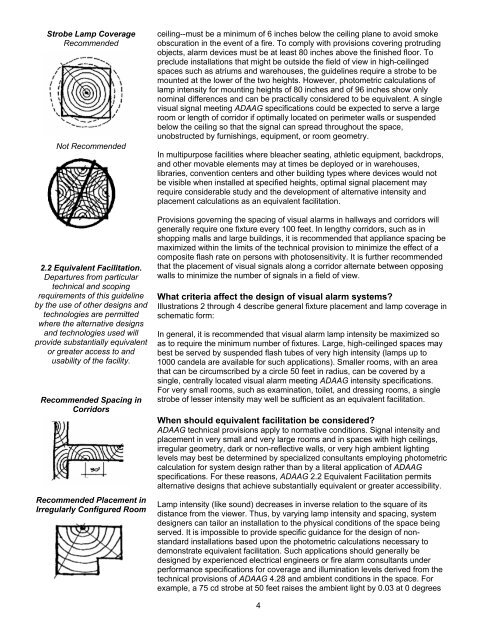Fire Protection Design Manual - Office of Construction and Facilities ...
Fire Protection Design Manual - Office of Construction and Facilities ...
Fire Protection Design Manual - Office of Construction and Facilities ...
Create successful ePaper yourself
Turn your PDF publications into a flip-book with our unique Google optimized e-Paper software.
Strobe Lamp Coverage<br />
Recommended<br />
Not Recommended<br />
2.2 Equivalent Facilitation.<br />
Departures from particular<br />
technical <strong>and</strong> scoping<br />
requirements <strong>of</strong> this guideline<br />
by the use <strong>of</strong> other designs <strong>and</strong><br />
technologies are permitted<br />
where the alternative designs<br />
<strong>and</strong> technologies used will<br />
provide substantially equivalent<br />
or greater access to <strong>and</strong><br />
usability <strong>of</strong> the facility.<br />
Recommended Spacing in<br />
Corridors<br />
Recommended Placement in<br />
Irregularly Configured Room<br />
ceiling--must be a minimum <strong>of</strong> 6 inches below the ceiling plane to avoid smoke<br />
obscuration in the event <strong>of</strong> a fire. To comply with provisions covering protruding<br />
objects, alarm devices must be at least 80 inches above the finished floor. To<br />
preclude installations that might be outside the field <strong>of</strong> view in high-ceilinged<br />
spaces such as atriums <strong>and</strong> warehouses, the guidelines require a strobe to be<br />
mounted at the lower <strong>of</strong> the two heights. However, photometric calculations <strong>of</strong><br />
lamp intensity for mounting heights <strong>of</strong> 80 inches <strong>and</strong> <strong>of</strong> 96 inches show only<br />
nominal differences <strong>and</strong> can be practically considered to be equivalent. A single<br />
visual signal meeting ADAAG specifications could be expected to serve a large<br />
room or length <strong>of</strong> corridor if optimally located on perimeter walls or suspended<br />
below the ceiling so that the signal can spread throughout the space,<br />
unobstructed by furnishings, equipment, or room geometry.<br />
In multipurpose facilities where bleacher seating, athletic equipment, backdrops,<br />
<strong>and</strong> other movable elements may at times be deployed or in warehouses,<br />
libraries, convention centers <strong>and</strong> other building types where devices would not<br />
be visible when installed at specified heights, optimal signal placement may<br />
require considerable study <strong>and</strong> the development <strong>of</strong> alternative intensity <strong>and</strong><br />
placement calculations as an equivalent facilitation.<br />
Provisions governing the spacing <strong>of</strong> visual alarms in hallways <strong>and</strong> corridors will<br />
generally require one fixture every 100 feet. In lengthy corridors, such as in<br />
shopping malls <strong>and</strong> large buildings, it is recommended that appliance spacing be<br />
maximized within the limits <strong>of</strong> the technical provision to minimize the effect <strong>of</strong> a<br />
composite flash rate on persons with photosensitivity. It is further recommended<br />
that the placement <strong>of</strong> visual signals along a corridor alternate between opposing<br />
walls to minimize the number <strong>of</strong> signals in a field <strong>of</strong> view.<br />
What criteria affect the design <strong>of</strong> visual alarm systems?<br />
Illustrations 2 through 4 describe general fixture placement <strong>and</strong> lamp coverage in<br />
schematic form:<br />
In general, it is recommended that visual alarm lamp intensity be maximized so<br />
as to require the minimum number <strong>of</strong> fixtures. Large, high-ceilinged spaces may<br />
best be served by suspended flash tubes <strong>of</strong> very high intensity (lamps up to<br />
1000 c<strong>and</strong>ela are available for such applications). Smaller rooms, with an area<br />
that can be circumscribed by a circle 50 feet in radius, can be covered by a<br />
single, centrally located visual alarm meeting ADAAG intensity specifications.<br />
For very small rooms, such as examination, toilet, <strong>and</strong> dressing rooms, a single<br />
strobe <strong>of</strong> lesser intensity may well be sufficient as an equivalent facilitation.<br />
When should equivalent facilitation be considered?<br />
ADAAG technical provisions apply to normative conditions. Signal intensity <strong>and</strong><br />
placement in very small <strong>and</strong> very large rooms <strong>and</strong> in spaces with high ceilings,<br />
irregular geometry, dark or non-reflective walls, or very high ambient lighting<br />
levels may best be determined by specialized consultants employing photometric<br />
calculation for system design rather than by a literal application <strong>of</strong> ADAAG<br />
specifications. For these reasons, ADAAG 2.2 Equivalent Facilitation permits<br />
alternative designs that achieve substantially equivalent or greater accessibility.<br />
Lamp intensity (like sound) decreases in inverse relation to the square <strong>of</strong> its<br />
distance from the viewer. Thus, by varying lamp intensity <strong>and</strong> spacing, system<br />
designers can tailor an installation to the physical conditions <strong>of</strong> the space being<br />
served. It is impossible to provide specific guidance for the design <strong>of</strong> nonst<strong>and</strong>ard<br />
installations based upon the photometric calculations necessary to<br />
demonstrate equivalent facilitation. Such applications should generally be<br />
designed by experienced electrical engineers or fire alarm consultants under<br />
performance specifications for coverage <strong>and</strong> illumination levels derived from the<br />
technical provisions <strong>of</strong> ADAAG 4.28 <strong>and</strong> ambient conditions in the space. For<br />
example, a 75 cd strobe at 50 feet raises the ambient light by 0.03 at 0 degrees<br />
4

















